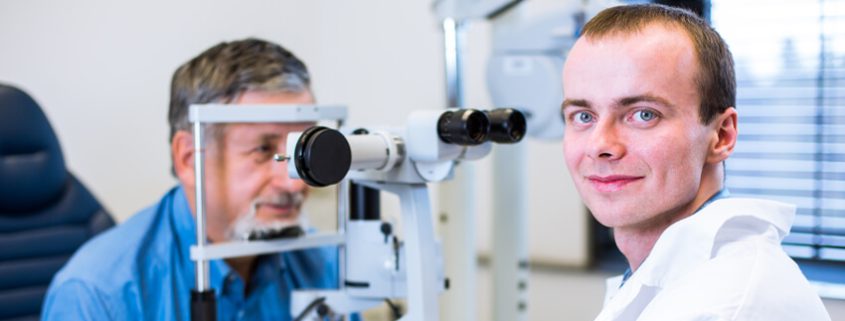What Does a Cataract Look Like? Discover How Is It Developed
When Should I Have Cataract Surgery?
Since cataract surgery is the most common eye surgery procedure, it’s likely you know at least one person who’s had this operation. Despite cataracts being so common, many people still wonder what does a cataract look like, and how to tell if they’re developing one. So, what does a cataract look like and how do you know if it’s time for cataract surgery?
What Does a Cataract Look Like?
A cataract is any haze or opacity of the crystalline lens in your eye. This lens is one of the structures that light passes through when you’re trying to see objects. A healthy lens starts as transparent at birth, which means that light can enter the eye easily, supporting clear and sharp sight. However, as we get older, the crystalline lens gradually begins to lose its transparency, developing opaque areas or an overall cloudiness. While most cataracts and cases of cataract surgery are a result of older age, cataracts can also be caused by other reasons, including systemic diseases or injuries.
You may begin to suspect you’re on the way to needing cataract surgery when you start experiencing symptoms such as:
A decline in the quality of your sight
Since the cataract is physically interfering with the passage of light into the eyeball, you will slowly find that the quality of your vision is deteriorating. While some may describe this experience as blurry, others may consider it more like filmy, foggy, hazy, or cloudy. It is not uncommon to describe the sight through a cataract as like looking through a dirty window. Even if you can’t pinpoint the changes to the quality of your sight, you may be aware that certain tasks are becoming increasingly difficult. For example, recognising faces from a distance or reading the small print of food ingredients or on medicine packaging.
Increasing glare sensitivity
Another name for glare sensitivity is photophobia. Everyone has some degree of sensitivity to overly bright lights, however, as cataracts develop, you may find your photophobia worsening. It is common for this symptom of cataract to be most apparent when driving at night. The glare of oncoming car headlights or overhead street lights can be particularly debilitating and uncomfortable. Certain types of cataracts are more likely to cause photophobia than others. Posterior subcapsular cataract and anterior cortical cataracts cause light particles to scatter as they enter the lens, which we then perceive as glare. If your glare sensitivity is particularly bad, you may decide to proceed with cataract surgery, even if the rest of your sight is reasonable.
Decreasing contrast sensitivity
We don’t often think of contrast sensitivity when it comes to our sight, but it’s an important aspect. Contrast sensitivity allows us to discern faint detail against a background, or to pick out differences in shades and patterns. For example, being able to find the edge of the curb between the pavement and the road, or the outline of a silver car ahead of you through heavy rain. One of the common symptoms of cataract is a decrease in your contrast sensitivity. In addition to finding the previous examples more difficult as your cataracts progress, many patients also report increasing difficulty in reading print in low ambient lighting conditions. You may find you need to use the illumination from your smartphone to read a restaurant menu or bring your newspaper to the window.
Changes to your colour perception
One particular type of cataract called nuclear sclerosis develops as a yellow-brownish haze in the lens. This results in filtering out certain wavelengths of light, which then changes your colour perception. This symptom of a cataract is not often noticed as the change happens very slowly. However, some people who require very fine colour discrimination for their hobbies or occupation may find their colour perception is not as accurate as it once was.
Should I Have Cataract Surgery?
 The timing of eye surgery for your cataracts is largely guided by the impact they’re having on your lifestyle and daily tasks. This can vary widely from individual to individual, as everyone enjoys different activities with different visual demands.
The timing of eye surgery for your cataracts is largely guided by the impact they’re having on your lifestyle and daily tasks. This can vary widely from individual to individual, as everyone enjoys different activities with different visual demands.
Your eye care professional can give you some guidance as to the right timing of cataract surgery after assessing your cataract. What does a cataract look like to your eye care professional? Cataracts are very straightforward to diagnose. Your eyecare practitioner can make a quick diagnosis simply by viewing the cataracts directly behind a slit lamp, which is a magnification and light system. In addition to this, by gauging the impact of the cataracts on your sight and daily tasks through visual acuity testing and your own reports, your clinician will be able to have an idea of whether eye surgery for cataracts in the near future would be recommended.
Cataract surgery is typically an uncomplicated, effective procedure. It is the only way of definitively treating a cataract. If you don’t feel ready for cataract surgery just yet, your eyecare professional may be able to suggest other temporary solutions, such as improving the task lighting when you’re trying to read, or updating your prescription.
If you do decide to go ahead with eye surgery for your cataracts, you may elect to either go via the private or the public healthcare system. The public healthcare system may have a waiting list in excess of 12 to 18 months, but the procedure will be at no cost to you. Conversely, seeing a private ophthalmologist will mean you can have your cataract surgery completed sooner. The cost of your operation will depend on any private health insurance coverage. You may wish to discuss with your eye care practitioner about which is best for you.
Contact us now on (03) 9070 3580 for a consultation.
Note: Any surgical or invasive procedure carries risks. Before proceeding, you should seek a second opinion from an appropriately qualified health practitioner.
References
Cataracts – Symptoms and causes
https://www.mayoclinic.org/diseases-conditions/cataracts/symptoms-causes/syc-20353790#:~:text=A%20cataract%20is%20a%20clouding,frosty%20or%20fogged%2Dup%20window.
Cataracts – symptoms, those at risk, treatments
https://www.healthdirect.gov.au/cataracts






Leave a Reply
Want to join the discussion?Feel free to contribute!